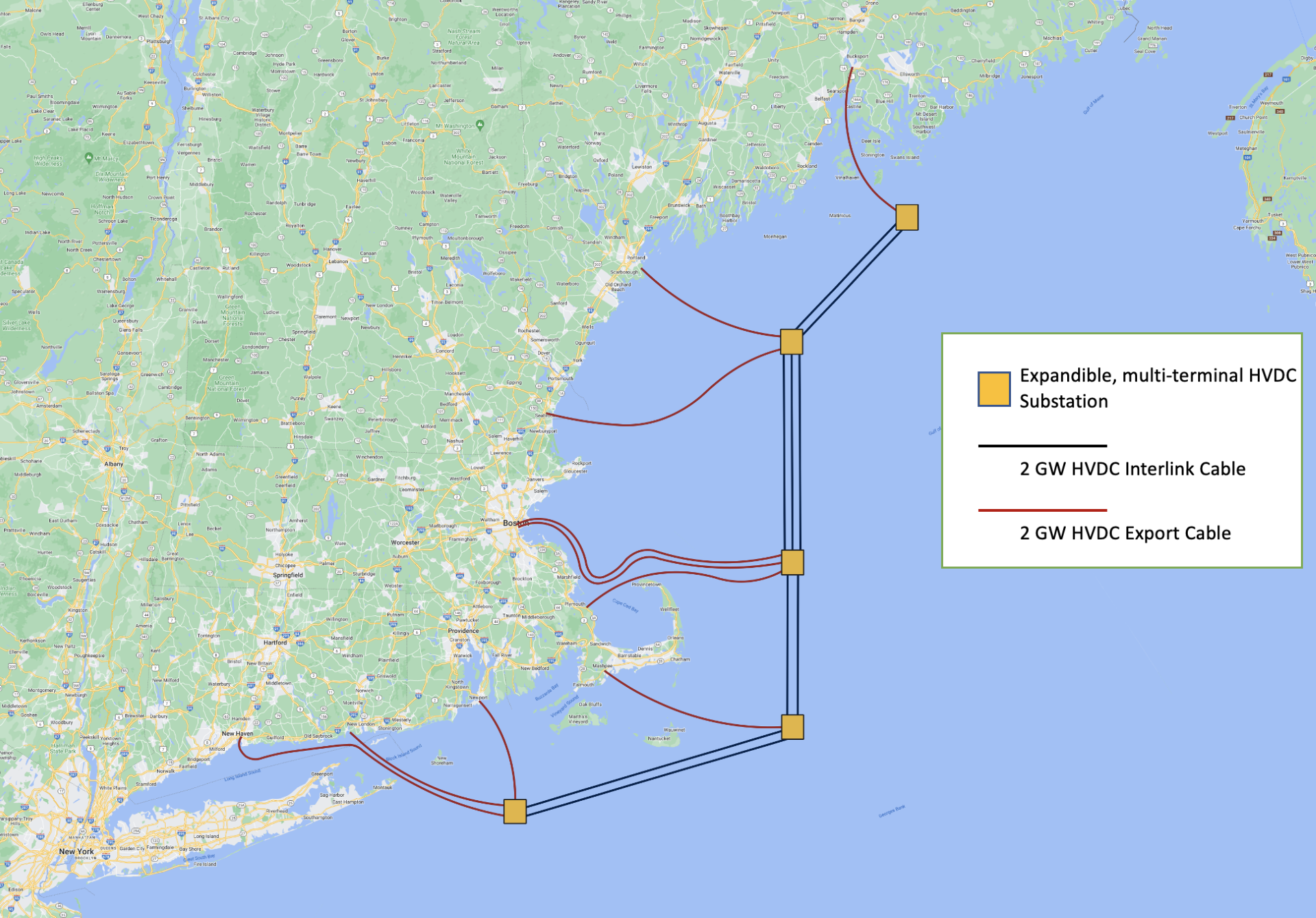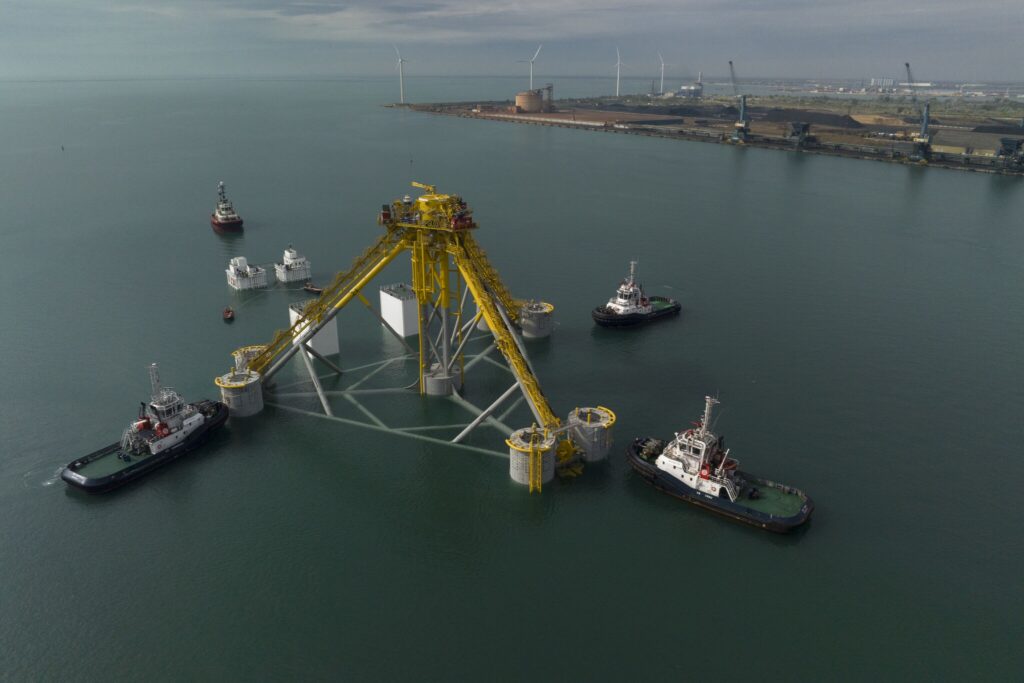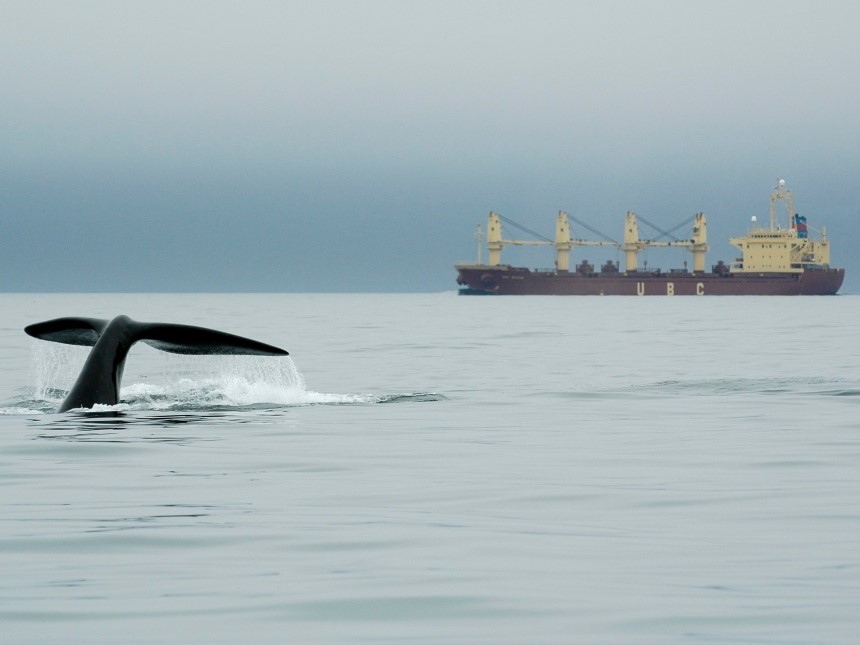TWIST IN THE TAIL: A right whale dives near a tanker in Canada’s Bay of Fundy (Foto: New England Aquarium)
Multi-billion-dollar visions of a massive offshore wind-powered transmission trunkline running along the US east coast are not new, yet none has made it from computer screen to reality. Now, however, writes Darius Snieckus, a heavyweight consortium is scoping a plan linking the Canadian Maritimes and Gulf of Maine it believes can unlock a long-stranded resource and transform the North American Atlantic
By Darius Snieckus
So mighty are the winds that blow off the Canadian province of Nova Scotia that they feature in the creation myth of the area’s indigenous Mi'kmaq. Yet efforts over the past decade to construct offshore wind farms to harness a resource judged to rival the North Sea’s have all failed to get out of harbor due the lack of urban and industrial power demand in the region.
A cadre of pioneering offshore wind players aims to create a sea-change in thinking on the question. The New England-Maritimes Offshore Energy Corridor (NEMOEC) consortium – which includes developers Hexicon, DP Energy and Northland Power – calculates a 2GW high voltage direct current (HVDC) trunkline running 621 miles (1,000km) from the Canadian Maritimes to the Gulf of Maine could be built that would deliver “economic and environmental benefits” of up to $800m a year. And that’s for a start.
“Finding new, economic routes to market for Nova Scotia offshore winds started the thinking on [NEMOEC],” says Abby Watson, president of Groundwire Strategies, which acted as the coordinator for the consortium and the project’s consultancies, DNV and Power Advisory. “The province has this absolutely incredible, world-class wind resource – I believe it will be the cheapest offshore wind in the world – but who’s going to buy that electricity?

'The NEMOEC project provides a lot of optionality for offshore wind developments both off Nova Scotia and in the Gulf of Maine, which would give developers a lot more confidence in these nascent plays."
Abby Watson
President
Groundwire Strategies
“Obviously, the province does need some of this electricity, based on its net-zero ambitions, and then there's the potential to supply green power production to hydrogen developers in the region. But, you know, developers are often looking for multiple routes to market to make sure that there's true commercial viability for a project, particularly in a new market.
“What we are proposing with the NEMOEC project is a lot of optionality for offshore wind developments both off Nova Scotia and in the Gulf of Maine,” says Watson, “which would give developers a lot more confidence in these nascent plays. But, to be sure, this is ambitious idea.”
New-model offshore wind-powered trunkline
Doubly so, given the visions of an offshore wind-powered ‘superhighway’ running along the US east coast seafloor have been mooted for some time, including the high-profile Atlantic Wind Connection backed by internet behemoth Google, Swiss green-energy private-equity house Good Energies, Japanese industrial conglomerate Marubeni, and Belgian transmission system operator Elia.
“There has been a lot of good thinking on [long distance underwater power trunklines] over the last 20 years that concluded ‘we can do this’,” says Theodore Paradise, Hexicon’s chief policy and legal officer for North America. “But once you look at the pricing and the [non-renewable] alternatives, the thinking stopped when it came to this idea making economic sense for the energy system we had then – even taking in what was forecast to be on the horizon once offshore wind started to be built.”

“Now though, with the shift to renewables [globally] coming in concert with other things – economics, retiring oil- and then coal-fired plants, the general ramp-up of offshore wind off the US Northeast and now off Nova Scotia [where the province is planning to auction a first 5GW in 2025] we are facing a new reality.
“And for floating and bottom-fixed offshore wind developers which have concentrated on radial [export] lines for their projects, [the NEMOEC concept] would prevent them from designing themselves out of connecting to later developments and then the changing economics becomes an existential issue,” says Paradise. “This is about thinking in our long-term interest, not just building the next, cheapest offshore wind project, building the infrastructure to make this all work.”
With Nova Scotia having recently set the clock ticking on a first offshore wind leasing round through which is aims to build some 5GW of plant, and the state of Maine scouting development of a gigascale fleet now that its floating wind flagship, Aqua Ventus, is moving through the federal permitting process apace, the NEMOEC project could be very timely.
“The province has set a target to offer first leases by 2025 to support green hydrogen development,” Watson notes. “However, integrating this volume of generation to the Nova Scotia electricity grid will be a challenge and the incremental demand for renewable energy there is likely to be relatively modest given provincial electricity demand. A transmission interconnection with New England could reduce renewable energy supply costs and provide valuable optionality.”
'This is about thinking in our long-term interest, not just building the next, cheapest offshore wind project'
Theodore Paradise
Chief Policy & Legal Officer
Hexicon

“But this is not an export play,” she adds. “This is a balancing resource for the region. The Gulf of Maine auction is coming next year, 2025 for Nova Scotia. This a blank slate for us to plan this from the beginning.”
NEMOEC have worked through a range of technology “pathways” for the energy corridor envisaged, connecting future arrays in the wind-rich Sable Island and South of Halifax zones to those set to be installed in the Gulf of Maine. At its most basic, the trunkline would be a 525kV bipole HVDC line with converter stations, costed at $6bn, linking Sable Island plant south to the New England grid; at its most ambitious, priced at $8bn, the line would be built around a combination of the technology used in the lowest-cost concept, but with a trio of HVAC substations at spur-points, to send power to shore.
Pathway one, the least expensive option, is “an attractive starting point for further exploration of the NEMOEC vision”, but the highest sticker price scenario would have the “most reduced” environmental impact and the bonus of additional interlink lines in the Canadian Maritimes, says Paradise.
“Scaled development of the NEMOEC line will support growth for developers, which in turn will allow for economics-boosting further expansion of the offshore power transmission infrastructure.
“More projects is good for developers and grid operators, whether you're talking about Nova Scotia, New Brunswick, New England ISO, and means you're also talking about a more connected system. And since the difference between reliability and certainty, between higher and lower prices, is just having export capability, geographic diversity [of a grid] levels out variability,” says Paradise.

'It's most important that cross-border transmission planning is being look at from an "energy system" perspective, moving away from the province- or state-level approach to something bigger. Electrons know no borders'
Sven Scholtysik
Director of Research
Net Zero Atlantic
“Get a HVDC system that is big enough and distance doesn't really matter: it starts to look like those resources are right in your backyard at that kind of voltage, and part of a really robust, really reliable system.”
Green electrons and molecules
Given Canada’s emerging strategic focus on green hydrogen production and export – and the limits on power consumption in Nova Scotia, NEMOEC – which has Halifax-headquartered Bear Head Energy on its roster – sees clear potential in working “across green electrons and molecules”.
“Construction of the NEMOEC energy corridor should be a help to hydrogen. Scale-up brings development and operations costs down and so brings electricity prices down and cheaper electricity – because all generations ‘looks’ the same – means lower-cost hydrogen,” says Paradise.
Sven Scholtysik, director of research at Net Zero Atlantic, a Halifax-based energy R&D outfit focused on Canada’s transition to a carbon-neutral society that has helped raise the profile of the NEMOEC work, sees hydrogen generation as key among the “boxes ticked” making the case for a gigascale, cross-border power trunkline.
“Cross-border transmission planning is becoming important around the world but especially in Canada and the US given the strong historical ties [between the countries]. But it most important that it be look at from an ‘energy system’ perspective, moving away from the province- or state-level approach to something bigger. Electrons know no borders.
“[NEMOEC] could help break down the belief system got broken up and people began to think about using the wind resources we have to both decarbonize our system while acting as a strategic partner for another jurisdiction which maybe has greater demand than available supply of offshore wind, in this case,” says Scholtysik.
“The hydrogen discussion you can look out to any number of markets where there is heavy population density and industry that needs decarbonizing but not the wind resources [of the North American Atlantic] that can be tapped into readily. There is very interesting potential here.”

As an infrastructure – rather than power generation – project, the NEMOEC concept would also “unlock” a portfolio of offshore wind development plans in deeper Atlantic waters, Paradise says.
“For floating wind to achieve its full potential on this planet it needs infrastructure to unlock it. By having a ‘backbone’ transmission system such as we are describing, with various connections to shore, you’ll be able to flow power [from a floating wind farm] to a number of different grid connection points.
“And that makes the risk case and logistics of building in deeper water, whether Central Atlantic, Gulf of Maine, Atlantic Canada, more palatable, ‘easier’ to do.” Off Nova Scotia interest among floating wind developers has been growing, with DP Energy and tension-leg platform designer SBM the latest to declare plans to explore the emerging market.
Though the accent in NEMOEC’s white paper on its offshore wind-powered trunkline concept is placed first on the cost proposition – and indeed the next stage in its work will concentrate on the “quantifying the full economic case from clean power to investment and jobs, the project would also bring significant “non-monetizable” benefit through the accompanying industrial transformation and economic development, underlines Watson.
“The question of social acceptance, of just transition, was very much the first organising principles of NEMOEC,” says Watson. “This energy corridor responds to the concerns of stakeholders around many different impacts – especially compared to any radial system [of transmission lines] which would be exponentially more damaging – while also enabling a more cost-effective transmission solution. A win-win. Not we have to be relentless in our efforts to get it built.”
This article was part of Aegir Insights' intelligence newsletter, Beaufort:
Delivered straight to your inbox every Sunday, Beaufort will sharpen your market insight for the week ahead with exclusive commentary, analysis, and in-depth journalism delving into the talking points and technologies shaping offshore wind.
Sign up for free here.
